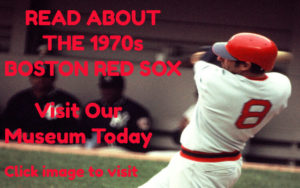The 1983 Boston Red Sox: The Farewell For Carl Yastrzemski
It was 1961 that a kid from Long Island who played basketball at Notre Dame made his major league debut with the Boston Red Sox. That kid was Carl Yastrzemski and the next 22 years saw become a hero across New England. “Yaz” led the Red Sox to the Impossible Dream pennant of 1967, to another pennant in 1975, won the Triple Crown in 1967 and stayed a productive player into his 40s. Finally, at age 43, he called it quits on what would be a first-ballot Hall of Fame career. The 1983 Boston Red Sox season was Yaz’s last.
Yaz was getting out at a good time, because after contending consistently through the 1970s, the Red Sox started to fall on hard times. They weren’t a bad team by any stretch, and they had some young players that would eventually be part of future contenders in the latter part of the 1980s. But in an age where the only path to the postseason was to finish first in a seven-team AL East, the Red Sox were nowhere close.
Pitching was the problem. Boston ranked 12th in the American League in ERA in 1983, with no regular starting pitcher having an ERA under 4.00. John Tudor was the “ace” of the staff, if we can even use that word in this context, at 13-12 and 4.09. Bruce Hurst got his first regular shot at a big-league rotation and at 12-12 and 4.09, showed he had real potential at age 25. But being the #2 starter in a rotation was still asking a little too much.
Dennis Eckersley’s career seemed to be falling apart, ad he struggled to a 9-13 record and his ERA soared to 5.61. One year later “Eck” would be traded to the Chicago Cubs, although it was not until his next stop in Oakland that Tony LaRussa made him a closer and saved his career.
The Red Sox brought up Oil Can Boyd and gave him 13 starts. Boyd pitched well, with a 3.28 ERA. The only other bright spot on the staff was reliever Bob Stanley. The Steamer saved 33 games with a 2.85 ERA, but the rest of the bullpen was atrocious.
It meant that Yaz and his offensive mates would have to do a lot of scoring. And the Red Sox did hit the ball pretty well in 1983, albeit not good enough to compensate for this pitching staff. Jim Rice hit 39 homes and had 126 RBIS in left field, while Tony Armas went deep 36 times and drove in 107 runs. Dwight Evans had a .388 on-base percentage in right field, completing a solid outfield.
Armas was a new acquisition, coming over from Oakland in a deal built around him and third baseman Carney Lansford, who Boston sent west. In spite of Armas’ power numbers, his on-base percentage was terrible (.254) and he was the classic “all sizzle no steak” offensive player, whose only productive at-bats came when he was hitting it deep. Lansford enjoyed several productive years in Oakland, but that didn’t make the trade a failure for Boston.
Lansford needed to be dealt, because the Red Sox were committed to a new third baseman by the name of Wade Boggs. And with his razor-sharp batting eye leading to a .444 on-base percentage, and superb contact hitting ability leading to a batting title at .361, just getting Boggs in the lineup was worth it.
The Red Sox finished sixth in the league in runs scored, held back by poor production at catcher (where Rich Gedman was not ready), first base (where Dave Stapleton’s inability to take a walk finally caught up to him), second base (where Jerry Remy was fading) and shortstop (where no one ever expected Glenn Hoffman to hit).
And Yaz? His numbers might not be dazzling anymore, but with a .359 on-base percentage, the DH was still a contributing part of a good offense.
The Red Sox started the season reasonably well, with a 26-20 opening. From May 4 to June 7 they spent a handful of days in first place and were never more than a couple games off the lead. Any optimistic ideas of a magic ending for Yaz came crashing down in a homestand with the Detroit Tigers and Baltimore Orioles.
Detroit came in on Monday, June 6 to start a four-game set. Boston led the opener 5-4 in the seventh, but Stanley was destroyed for seven runs. The offense failed on Tuesday and Wednesday, including being shut down by Tiger ace Jack Morris. And in Thursday’s finale, Eckersley was pounded for six runs in the fifth to complete the sweep.
Baltimore was next, and in Friday’s opener, the Sox could muster only three hits off Storm Davis in a 3-0 loss. The Orioles crushed lefty Bob Ojeda on Saturday, winning 100-6. The Red Sox salvaged a game on Sunday—trailing 6-5, they tied it in the eighth, and then won it when Boggs drew a two-out, bases-loaded walk in the ninth. But the damage was done.
The Tigers and Orioles represented the next two World Series champions, the Birds on their way to a title in 1983 and the Tigers would do it in 1984. This week of games at Fenway Park dropped the Red Sox five games off the pace and showed how far the gap really was between them and the contenders in their division.
It didn’t mean Boston mailed it in on the season. Even though they never got closer than four games, they played respectably until August. Then a trip to Milwaukee—who had won the AL pennant the prior year—was the final death knell.
In a four-game set, the Red Sox offense went silent. They had 30 hits over the four games, which isn’t bad on its face, but when 28 of them are singles, you aren’t going to score much. When your big guns—Rice and Armas, combine to go 3-for-33, with all three hits being singles, you aren’t going to score much. And Boston didn’t, scoring seven runs in four games and being swept
The Red Sox were on their way to their first losing season since 1971, ending at 78-84. But there was still one great special moment left. The final series of the year was at home against the Cleveland Indians, and Yaz took a victory lap around Fenway to get his due from the faithful. In his final game, he went 1-for-3 and the Sox won. The 1983 Boston Red Sox weren’t a very good team, but thanks to their captain, they still had some magic in them.


